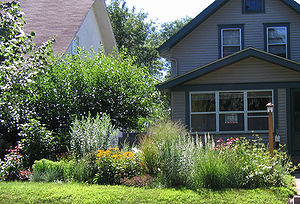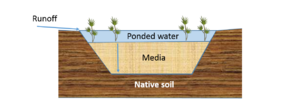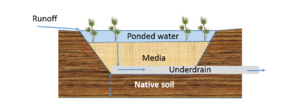
Difference between revisions of "Rain gardens (bioretention) 101"
(Created page with "300px|thumb|alt=bioretention photo|<font size=3>This bioretention basin utilizes several native species.</font size> file:Schematic no under...") |
|||
| (One intermediate revision by the same user not shown) | |||
| Line 33: | Line 33: | ||
==More information== | ==More information== | ||
*[https://www.epa.gov/soakuptherain/soak-rain-rain-gardens Soak Up the Rain: Rain Gardens] (U.S. EPA) | *[https://www.epa.gov/soakuptherain/soak-rain-rain-gardens Soak Up the Rain: Rain Gardens] (U.S. EPA) | ||
| − | |||
*[http://www.raingardennetwork.com/ What is a rain garden] (Rain Garden Network) | *[http://www.raingardennetwork.com/ What is a rain garden] (Rain Garden Network) | ||
*[http://www.ci.maplewood.mn.us/1032/Rain-Gardens Rain Gardens] (Maplewood Minnesota) | *[http://www.ci.maplewood.mn.us/1032/Rain-Gardens Rain Gardens] (Maplewood Minnesota) | ||
*[http://www.capitolregionwd.org/residents/rain-gardens/ Rain Gardens] (Capitol Region Watershed District) | *[http://www.capitolregionwd.org/residents/rain-gardens/ Rain Gardens] (Capitol Region Watershed District) | ||
*[http://www.blue-thumb.org/raingardens/ Raingardens] (Blue Thumb) | *[http://www.blue-thumb.org/raingardens/ Raingardens] (Blue Thumb) | ||
| + | |||
| + | [[Category:Level 3 - Best management practices/Structural practices/Bioretention]] | ||
Latest revision as of 13:08, 2 February 2023
Rain gardens, also called bioretention basins, are planted depressions that collect stormwater runoff from impervious surfaces, such as roofs and streets, and filter pollutants out of the runoff water. There are two basic types of rain gardens, as shown on the right. Rain gardens with no underdrain allow allow captured runoff water to infiltrate into the underlying soil. They are therefore effective at removing water and pollutants. Rain gardens that have an underdrain filter pollutants, but most of the filtered water is captured by the drain and returned to the storm sewer system, where it will eventually be discharged to a lake or river.
Contents
How does a rain garden work?
Rain gardens have a relatively simple design. Native soil is dug up and replaced with a special engineered media that is designed to support plant growth but allow water to pass through quickly. This media consists mostly of sand but has organic matter (e.g. compost) and some clay. The sand allows water to pass through the media quickly, while the clay and organic matter hold enough water and nutrients to support plants. The organic matter and clay are also effective at adsorbing pollutants from the runoff water.
Water from an impervious surface is routed to the rain garden, where it ponds until the basin is full or runoff stops. Examples of how water is routed to a rain garden include a cut in a street curb to allow water to enter or direct discharge from a roof gutter. The ponded water soaks through the media and either percolates down into the underlying native soil, or is captured by the underdrain and returned to the storm sewer system. The ponded water must all drain within a day or two so that plants do not remain inundated with water and to create space for the next rain event.
Rain gardens should not be more than 1.5 feet deep, even when water drains quickly. This prevents plants from becoming totally submerged.
How effective are rain gardens?
Rain gardens that do not have an underdrain are very effective at capturing water and pollutants. All water captured by the rain garden and all pollutants in that water are removed from the storm sewer system. Rain gardens that have an underdrain are less effective. Most of the water that enters the rain garden, typically 80 percent or more, will be captured by the underdrain and returned to the storm sewer system. the remaining 20 percent or so of the water will soak into the soil beneath the underdrain. For water that is captured by the underdrain, about 85 percent of the total solids and 45 percent of the total phosphorus will be removed as the water passes through the media.
Why would I need an underdrain?
Remembering that the water entering a rain garden needs to be completely removed within a day or two, soils that have low infiltration rates will not be able to infiltrate the water quickly enough. These typically include soils with a high clay content. An underdrain is thus built into rain gardens in these soils to facilitate drainage.
What types of plants can be grown in a rain garden?
A variety of native perennials are best. Shrubs and trees are also encouraged but must be planted away from the point where water enters the rain garden. Plants located at the bottom of the rain garden should be water tolerant, while those located higher in the rain garden should be drought tolerant. This is one reason why perennials are the best option, since many are adapted to fluctuating soil moisture. For more information on plants, see this page.
What maintenance is needed for a rain garden?
Rain gardens need routine maintenance. The point where water enters the rain garden must be inspected roughly monthly to ensure that it is not clogged with soil or trash. Vegetation should be inspected roughly every two months to make sure it is healthy and to remove weeds. Trash and excess soil should be removed at this time. care must be taken to ensure that soils in the rain garden and vegetation are not trampled and compacted. Do not fertilize the vegetation.
What are the advantages and disadvantages of rain gardens?
Rain gardens are effective at treating stormwater. They are aesthetically pleasing and can help promote biodiversity (e.g. they attract butterflies, etc.). They are relatively simple to design and maintain and can be fit into many different urban settings.
Most rain gardens are relatively small since construction and maintenance of large rain gardens becomes difficult. Since they take up space, they cannot easily be used in highly urban settings, such as a downtown area. The first year of maintenance can be challenging as plants become established. Since rain gardens are typically small, they cannot treat large volumes of runoff.
More information
- Soak Up the Rain: Rain Gardens (U.S. EPA)
- What is a rain garden (Rain Garden Network)
- Rain Gardens (Maplewood Minnesota)
- Rain Gardens (Capitol Region Watershed District)
- Raingardens (Blue Thumb)
This page was last edited on 2 February 2023, at 13:08.


